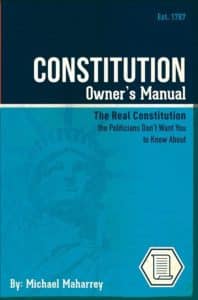What does the Constitution mean, and who gets to decide? Such a question has been answered in written form by political pundits, lawyers, and academics. Most of these accounts, however, rely upon a pre-determined ideological narrative that routinely obfuscates an impartial view.
Defying these trends, Mike Maharrey’s new work dares to answer the question by revisiting the writings and speeches of the ratification struggle and draws conclusions only through the records of the framework’s proponents. In the process, post-ratification legal precedents that contravene the original, widespread understanding – whether by executive action, federal laws, and high court decisions – are discarded entirely in an earnest effort to derive the truth.
To the contrary of the common trope that the Constitution is merely a living, breathing instrument that can be contorted by the will of the federal government, Mike points out that the document is one of enumerated powers, where the exercise of powers outside of this restrictive sphere are unauthorative.
Never intending the meaning of the Constitution to be at the mercy of federal judges, Maharrey articulates that those who wrote and ratified the framework intended it only to alterable through the strictly defined constitutional amendment process. Rather than leave an ambiguous roadmap to future generations, Mike demonstrates that the framework’s most passionate advocates explained the most controversial (and now oft-litigated) clauses in detail – leaving little to the imagination in regard to their purposes and limitations.
Rather than accept the portrayal of the Constitution by its fiercest enemies, it turns out, the states ratified that which was assured by the document’s friends.Among the best-researched facets of the book, Maharrey tackles the contentious subject of what was meant by the Constitution’s requirement that the president be a “natural born citizen.”
While most contemporary works on the Constitution cover the subject in a style that is strictly partisan, this one goes directly to pre-ratification legal texts and precedents to shed light on a subject that has almost never been tackled in an earnest way. Even though his general conclusion differs slightly from my own view, Maharrey’s book portrays the subject more objectively than I have ever seen in print.
Another of the book’s most impressive features is its coverage of war power. In particular, the work describes how the Constitution’s intended to subdue the war power of the American president, and make his execution of the war contingent upon Congressional discretion. Far from replicating the 18th-century British monarch, the founders deliberately lodged all war-making power with Congress, giving the executive the power to carry out war only after it had been first declared.
 Nullification – the now-forbidden principle that Thomas Jefferson characterized as the “rightful remedy” against federal usurpation – is given its share in Maharrey’s narrative. In his most lengthy chapter, the author illustrates the maxim as a natural extension of the founders’ legacy.
Nullification – the now-forbidden principle that Thomas Jefferson characterized as the “rightful remedy” against federal usurpation – is given its share in Maharrey’s narrative. In his most lengthy chapter, the author illustrates the maxim as a natural extension of the founders’ legacy.
To counter the mainstream suggestion that nullification was never anticipated or envisioned by the Constitution’s advocates, Maharrey goes back to the ratification debates to prove otherwise. In a manner that has rarely been utilized, he reveals several of the Constitution’s biggest supporters wrote and stated explicitly that the states could act to obstruct unconstitutional laws. Beyond this, as Madison insisted in The Federalist #46, the state governments could refuse to cooperate with the federal enforcement apparatus even when the laws they intended to carry out were merely unpopular (but still constitutional).
Maharrey’s new work is destined to stand the test of time, serving to remind us all that the Constitution was once promoted as an instrument to reign in the power over government rather than to justify its expansionary – and often treacherous – tendencies. It is both concise enough to equip layman with a broad understanding of the Constitution and thorough enough to intrigue academics that have studied the document and its history.
- Thomas Paine: A Lifetime of Radicalism - December 23, 2023
- Thomas Paine’s Return to America - September 19, 2023
- 9 Mostly-Ignored Facts About Independence Day - July 3, 2023
